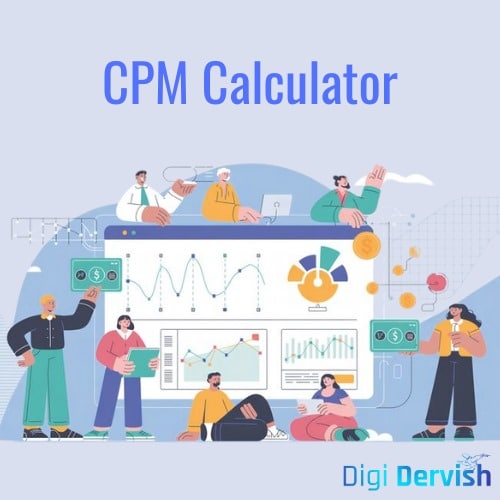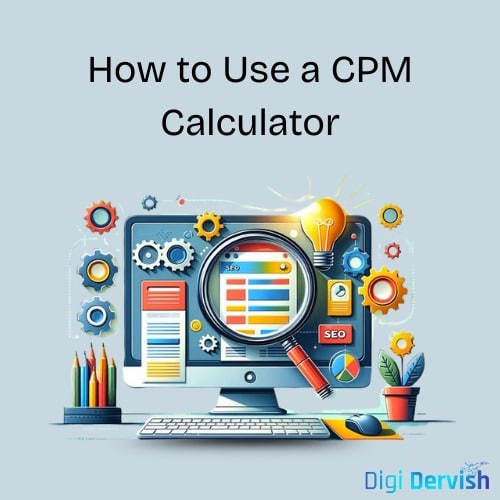
In the rapid-moving world of digital ads, data is all. Be it a Google Ads campaign, a Facebook campaign, or YouTube or programmatic platforms, understanding how your advertising budgets are allocated can make or break your success in this industry. One paramount metric in the digital marketing ecosystem is CPM or Cost Per Mille, meaning what it costs to get 1,000 ad impressions.
Yet, knowing the CPM for a given ad is one thing. To take control of your advertising execution, you will need to do so with the help of something called a CPM calculator: a simple yet powerful tool with which advertisers, marketers, and business owners calculate how much they are really spending for every 1,000 views of their ad.
This guide will take you through the definition and workings of a CPM calculator, why it’s needed, and how you can use it to heighten the ROI of your marketing campaigns. Whether starting and trying to understand CPM for the first time or being a seasoned digital marketer trying to polish the skill again, this guide intends to be your one-stop resource.
What Is CPM?
A CPM calculator mostly involves a simple formula to calculate CPM going from total advertising cost and the number of impressions the advert receives. Some sophisticated CPM calculators, however, go beyond just that-another way for you to work backward from known CPM to estimate how much you are spending, or to estimate how many impressions your budget will produce.
Key Variables in a CPM Calculation
A CPM calculator typically works with three primary variables:
- Total Cost: The amount spent on the advertising campaign. This is your total investment across a platform or time frame.
- Total Impressions: The number of times your ad was served or displayed to users. One impression equals one ad view.
- Cost per thousand impressions: : CTP: The calculated cost to serve 1,000 copies.
In your own way, a CPM calculator can help you calculate the missing value.
Use Case Examples:
- To Calculate CPM:
CPM = (Total Cost / Total Impressions) × 1,000 - To Calculate Impressions:
Impressions = (Total Cost / CPM) × 1,000 - To Calculate Cost:
Total Cost = (CPM × Impressions) / 1,000
So, this flexibility allows CPM calculators to be used by all kinds of advertisers: beginners handling smaller budgets, as well as media strategists buying over multiple platforms at scale.
Why Use a CPM Calculator?
Today, marketing advertisers try to do everything across avenues like Google Ads, Meta Ads (Facebook and Instagram), LinkedIn, TikTok, programmatic, etc. It may be complicated to watch a campaign’s cost-efficiency across so many outlets.
The CPM calculator brings clarity. Some of the benefits of the CPM calculator are:
1. Efficiency
Manually finding CPM across various campaigns can become time-consuming and prone to error. A CPM calculator will help you simplify the procedure and give you instant results accurately. If you intend to compare cost across platforms or ad sets, this becomes especially vital.
2. Budget Planning
The budget-apportioned impressions are forecasted by calculating the expected CPM before the campaign launch. Let’s say the CPM estimation is placed at $5, and the budget is $1,000; then a CPM calculator can be helpful in forecasting 200,000 impressions.
This is crucial for:
- Media planners
- Campaign strategists
- Digital marketing agencies
3. Performance Tracking
Post-launch, use a CPM calculator to evaluate real campaign results. You can:
- Compare CPMs across platforms (e.g., YouTube vs. Meta)
- Monitor CPM trends over time
- Optimize bids and targeting for better ROI
If one platform has a consistently high CPM, it might be a signal to revisit your ad creative, audience targeting, or bidding strategy.
4. Client Reporting & Justification
For agencies, CPM calculators are invaluable tools for client reporting. They allow account managers to break down how much a client is paying for visibility, and to justify budget reallocations with clear data.
5. Scenario Analysis
You can also use CPM calculators to model hypothetical campaign scenarios:
- “If my CPM increases by $1, how does that affect my reach?”
- “What budget do I need to reach 1 million impressions at $4 CPM?”
- “How does improving my targeting to lower CPM impact overall spend?”
Where to Use a CPM Calculator
You can use a CPM calculator in several environments, including:
- Online Tools: Web-based calculators (like the one embedded above) offer immediate results.
- Excel or Google Sheets: Perfect for multi-campaign tracking with formulas and charts.
- Custom Dashboards: Marketers often integrate CPM calculations into BI tools like Google Data Studio, Tableau, or Looker for deeper insights.
- Ad Platforms: Many platforms (e.g., Facebook Ads Manager, Google Ads) show CPM automatically, but using your own calculator ensures independence and consistency across platforms.
Who Should Use a CPM Calculator?
While CPM calculators are widely used in marketing, they are especially valuable to:
- Media Buyers
- Ad Managers
- PPC Specialists
- Digital Marketing Consultants
- Business Owners Running Paid Ads
- SaaS & eCommerce Teams Scaling Visibility
Even if we are talking about a small campaign, a moderate marketing effort on a global scale, or something in the mid-range, a CPM calculator will occupy top priority on your analytics list.
How to Use a CPM Calculator

Using this calculator instantly turns into a quick way of assessing your marketing efficiency. Whether your budget depends on the forthcoming ad campaign or on finalizing analyses post-agency, the process seems pretty straightforward and accessible for any beginner.
Below is an all-in-one guide describing the manual and digital use of CPM calculators, supported by real-world examples and suggested tools.
Step-by-Step Guide: Calculate CPM with Ease
Step 1: Enter Your Total Ad Spend
The entirety of all this is the amount allocated or spent on a given advertising business.
Example:
So let’s put it into context: suppose you spent $1,000 on a brand new advertising campaign with a Facebook Ad strategy.
Step 2: Enter the Total Number of Impressions
Next, see how many times a user’s browser has displayed your ad. Usually, this information can be gathered from your advertising platform dashboard (Google Ads, Meta Ads Manager).
Example:
The ad had 250,000 impressions during the campaign.
Step 3: Apply the CPM Formula
Now, plug your values into the CPM formula:
CPM = (Total Ad Spend / Total Impressions) × 1,000
In this case:
CPM = ($1,000 / 250,000) × 1,000 = $4.00
This means you paid $4.00 for every 1,000 ad impressions your campaign delivered.
Alternate Formula (Inverse Calculation)
If you’re using a reverse calculation (e.g., you know your CPM and impressions), you can estimate your total ad spend:
Total Cost = (CPM × Impressions) / 1,000
Or estimate impressions if budget and CPM are known:
Impressions = (Total Cost / CPM) × 1,000
These variations are particularly helpful for budget forecasting or adjusting campaign scale during A/B testing or optimization.
How to Use an Online CPM Calculator
While manual calculations are simple, online CPM calculators streamline the process even further. These tools typically require only two inputs—cost and impressions—and automatically compute the CPM (or vice versa).
Benefits of Using an Online CPM Calculator
- Instant Results: No need to enter formulas or use spreadsheets
- Accuracy: Reduces human error, especially in high-volume campaigns
- Reverse Calculation Support: Many calculators can compute cost or impressions if CPM is known
- Mobile-Friendly: Ideal for quick checks on the go or during client meetings
Recommended Online CPM Calculator Tools
Here are some reliable, user-friendly options you can use right away:
- Calculator.net CPM Calculator
- Easy-to-use interface
- Supports multiple CPM-related calculations
- Great for quick planning sessions
- Easy-to-use interface
- Google Ads Cost Calculator (via Ads Platform)
- Part of the official Google Ads suite
- Built-in to campaign estimates
- Helps forecast impressions and budget based on targeting and bidding
- Part of the official Google Ads suite
- HubSpot Ads ROI Calculator
- Ideal for full ROI planning
- Includes CPM, CPC, and cost-per-lead estimates
- Ideal for full ROI planning
- Custom Google Sheets or Excel Templates
- Use your own formulas for multi-campaign tracking
- Great for in-house marketing teams needing flexibility
- Use your own formulas for multi-campaign tracking
Advanced Tip: Integrate CPM Calculations in Google Sheets
For those managing multiple ad campaigns or working within an agency, it can be useful to build your own CPM calculator into Google Sheets using this simple formula:
excel
CopyEdit
= (A2 / B2) * 1000
Where:
- A2 = Total Cost
- B2 = Total Impressions
This formula can be replicated across rows for multi-campaign dashboards, or connected to live ad data via Google Ads integrations.
When to Use a CPM Calculator
Here’s when a CPM calculator becomes especially helpful:
| Use Case | Why It’s Valuable |
| Planning a new campaign | Helps forecast reach and cost expectations |
| Comparing platform performance | Spot high or low CPMs across ad networks |
| Justifying budget changes to stakeholders | Back up spending decisions with hard numbers |
| Optimizing campaigns mid-flight | Reallocate budget from high-CPM to low-CPM ad sets |
| A/B testing creative | See how different creatives impact ad efficiency |
Why Is CPM Important in Digital Marketing? <a name=”why-is-cpm-important-in-digital-marketing”></a>
Marketers use CPM to measure and control advertising spend across a wide range of media types:
- Display Ads
- Video Ads
- Social Media Ads
- Email Marketing Impressions
- Podcast Sponsorships
Benefits of Using CPM:
- Predictable Costs
- Easier Budget Allocation
- Great for Brand Awareness Campaigns
CPM vs CPC vs CPA: Key Differences
| Metric | Full Form | Definition | Best For |
| CPM | Cost Per Mille | Pay per 1,000 views | Brand Awareness |
| CPC | Cost Per Click | Pay only when someone clicks | Direct Traffic |
| CPA | Cost Per Action | Pay when a specific action occurs (e.g., signup) | Conversions |
Tip: Use CPM when visibility matters, CPC when clicks matter, and CPA when conversions are king.
Real-World Examples of CPM Calculations
Example 1: YouTube Advertising
- Budget: $500
- Impressions: 200,000
- CPM = ($500 / 200,000) × 1,000 = $2.50
Example 2: Facebook Ad Campaign
- Spend: $750
- Reach: 150,000
- CPM = ($750 / 150,000) × 1,000 = $5.00
Pros and Cons of CPM Advertising <a name=”pros-and-cons-of-cpm-advertising”></a>
Pros:
- Easy to calculate
- Great for branding
- Scalable and predictable
Cons:
- Doesn’t guarantee engagement
- May lead to high costs with low ROI if not monitored
Top Platforms Where CPM Is Used Here are some leading platforms that operate on CPM-based pricing:
- Google Display Network
- Facebook Ads
- YouTube Ads
- Instagram Sponsored Posts
- LinkedIn Ads
- Programmatic Ad Exchanges (e.g., DoubleClick)
Each of these allows you to view and optimize CPM through their ad managers or via API integrations.
How to Lower Your CPM High CPM can eat up your ad budget quickly. Here’s how to optimize it:
Tips to Reduce CPM:
- Target a niche audience
- A/B test creative assets
- Optimize ad placement and timing
- Use mobile-optimized creatives
- Monitor frequency and avoid ad fatigue
Best Tools and Resources for CPM Analysis To go beyond basic calculation, use these professional tools:
- Google Analytics – Track performance across platforms
- Meta Business Suite – Optimize CPM for Facebook and Instagram
- AdEspresso by Hootsuite – A/B test creatives to lower CPM
- SEMrush & Ahrefs – Analyze competitor ad costs
Internal and External Linking Tip
Internal Links You Can Use (If This Post Is On Your Blog):
- Top Digital Marketing Metrics to Track
- Beginner’s Guide to Paid Advertising
- How to Set Up Google Ads Campaigns
Authoritative External Sources:
- Google Ads Help
- Facebook Business
- IAB (Interactive Advertising Bureau)
Adding these links boosts your SEO value and improves trust.
Use a CPM Calculator to Optimize Your ROI

Understanding CPM is crucial for anyone investing in digital advertising. A CPM calculator takes the guesswork out of measuring campaign costs and gives you insights that can improve your ad strategy, save budget, and boost visibility.
Whether you’re running display ads, promoting video content, or scaling up social media efforts, using a CPM calculator will help you keep costs in check and performance high.
Key Takeaways:
- CPM = Cost per 1,000 impressions
- CPM calculators provide clarity and control
- Use CPM alongside CPC and CPA for holistic marketing analysis
Call to Action: Digi Dervish
Ready to take control of your ad spend? Try a free CPM calculator today and optimize your campaigns for better ROI.



